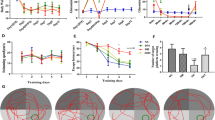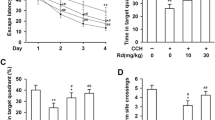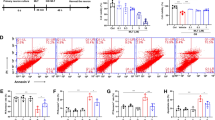Abstract
Neonatal hypoglycaemia initiates a series of events leading to neuronal death, even if glucose and glycogen stores return to normal. Disturbances in the cortical dopaminergic function affect memory and cognition. We recommend Bacopa monnieri extract or Bacoside A to treat neonatal hypoglycaemia. We investigated the alterations in dopaminergic functions by studying the Dopamine D1 and D2 receptor subtypes. Receptor-binding studies revealed a significant decrease (p < 0.001) in dopamine D1 receptor number in the hypoglycaemic condition, suggesting cognitive dysfunction. cAMP content was significantly (p < 0.001) downregulated in hypoglycaemic neonatal rats indicating the reduction in cell signalling of the dopamine D1 receptors. It is attributed to the deficits in spatial learning and memory. Hypoglycaemic neonatal rats treated with Bacopa extract alone and Bacoside A ameliorated the dopaminergic and cAMP imbalance as effectively as the glucose therapy. The upregulated Bax expression in the present study indicates the high cell death in hypoglycaemic neonatal rats. Enzyme assay of SOD confirmed cortical cell death due to free radical accumulation. The gene expression of SOD in the cortex was significantly downregulated (p < 0.001). Bacopa treatment showed a significant reversal in the altered gene expression parameters (p < 0.001) of Bax and SOD. Our results suggest that in the rat experimental model of neonatal hypoglycaemia, Bacopa extract improved alterations in D1, D2 receptor expression, cAMP signalling and cell death resulting from oxidative stress. This is an important area of study given the significant motor and cognitive impairment that may arise from neonatal hypoglycaemia if proper treatment is not implemented.






Similar content being viewed by others
References
Aral YZ, Gucuyener K, Atalay Y, Hasanoglu A, Turkyilmaz C, Sayal A, Biberoglu G (1998) Role of excitatory aminoacids in neonatal hypoglycemia. Acta Paediatr Jpn 40:303–306
Auer RN (1991) Excitotoxic mechanisms, and age-related susceptibility to brain damage in ischemia, hypoglycemia and toxic mussel poisoning. Neurotoxicology 12:541–546
Auer RN, Siesjo BK (1988) Biological differences between ischemia, hypoglycemia, and epilepsy. Ann Neurol 24:699–707
Auer RN, Siesjo BK (1993) Hypoglycaemia: brain neurochemistry and neuropathology. Baillieres Clin Endocrinol Metab 7:611–625
Azdad K, Gall D, Woods AS, Ledent C, Ferre S, Schiffmann SN (2009) Dopamine D2 and adenosine A2A receptors regulate NMDA-mediated excitation in accumbens neurons through A2A-D2 receptor heteromerization. Neuropsychopharmacology 34(4):972–986
Blanca ÁF, Irene CP (2011) Neonatal hypoglycemia: current concepts. In: Rigobelo E (ed) Hypoglycemia: causes and occurrences. InTech, Rijeka. ISBN: 978-953-307-657-7
Blattner RJ (1968) Central nervous system damage and hypoglycemia. Pediatrics 72:904–906
Burns CM, Rutherford MA, Boardman JP, Cowan FM (2008) Patterns of cerebral injury and neurodevelopmental outcomes after symptomatic neonatal hypoglycemia. Pediatrics 122:65–74
Butcher SP, Sandberg M, Hagberg H, Hamberger A (1987) Cellular origins of endogenous amino acids released into the extracellular fluid of the rat striatum during severe insulin-induced hypoglycemia. J Neurochem 48:722–728
Calabresi P, Centonze D, Pisani A, Bernardi G (1997) A possible mechanism for the aglycemia-induced depression of glutamatergic excitation in the striatum. J Cereb Blood Flow Metab 17:1121–1126
Cornblath M, Schwartz R (1976) Disorders of carbohydrate metabolism in infancy. WB Saunders, Philadelphia, pp 155–217
Creese I, Hess ES (1986) Biochemical characteristics of D1 dopamine receptors: relationship to behavior and schizophrenia. Clin Neuropharmacol 9(suppl. 4):14–16
Dunwiddie TV, Masino SA (2001) The role and regulation of adenosine in the central nervous system. Annu Rev Neurosci 24:31–55
Fowler JC (1993) Glucose deprivation results in a lactate preventable increase in adenosine and depression of synaptic transmission in rat hippocampal slices. J Neurochem 60:572–576
Glowinski J, Iversen LL (1966) Regional studies of catecholamines in the rat brain. J Neurochem 13:655–659
Gohil KJ, Patel JA (2010) A review on Bacopa monniera: current research and future prospects. Int J Green Pharm 4:1–9
Goldberg TE, Bigelow LB, Weinberger DR, Daniel DG, Kleinman JE (1991) Cognitive and behavioral effects of the coadministration of dextroamphetamine and haloperidol in schizophrenia. Am J Psychiatry 148(1):78–84
Gurden H, Takita M, Jay TM (2000) Essential role of D1 but not D2 receptors in the NMDA receptor-dependent long-term potentiation at hippocampal prefrontal cortex synapses in vivo. J Neurosci 20:RC106
Handa SS (1998) Indian herbal pharmacopoeia, vol 1. IDMA, Mumbai, pp 30–37
Hawdon JM (1999) Hypoglycaemia and the neonatal brain. Eur J Pediatr 158(Supp 1):S9–S12
Hernandez-Lopez S, Tkatch T, Perez-Garci E, Galarraga E, Bargas J, Hamm H, Surmeier DJ (2000) D2 dopamine receptors in striatal medium spiny neurons reduce L-type Ca2+ currents and excitability via a novel PLC [beta] 1-IP3-calcineurin-signaling cascade. J Neurosci 20(24):8987–8995
Hervé D, Rogard M, Lévi-Strauss M (1995) Molecular analysis of the multiple Golf subunit mRNAs in the rat brain. Mol Brain Res 32:125–134
Janssen PAJ, Niemegeers CJE, Awouters F, Schellwkens KHL et al (1988) Pharmacology of risperidone (R-64- 766). A new antipsychotic with serotonin-S2 and dopamine-D2 antagonistic properties. J Pharmacol Exp Ther 344:685–693
Jobin M, Jes P, Nandhu MS, Paulose CS (2010) Bacopa monnieri and Bacoside-A for ameliorating epilepsy associated behavioral deficits. Fitoterapia 8(1):5315–5322
Jones RAK, Roberton NRC (1984) Problems of the small-for-dates baby. Clin Obstet Gynecol 11:499–524
Junqing W, Junhui W, Zhaoming Z (2005) Oxidative stress in mouse brain exposed to lead. Ann Occup Hyg 50(4):405–409
Kalhan SC, Oliven A, King KC, Lucero C (1986) Role of glucose in the regulation of endogenous glucose production in the human newborn. Pediatr Res 20:49–51
Karp MM (1989) Hypoglycemia in diabetes among children and adolescents. Indian J Pediatr 56(Suppl 1):S93–S98
Kiritikar KR, Basu BD (1994) Indian medicinal plants, vol I. Bishen Singh Mahendrapal Singh, Dehradun, pp 1816–1817
Lidow MS, Goldman-Rakic PS (1994) A common action of clozapine, haloperidol and remoxipride on D1- and D2-dopamine receptors in the primate cerebral cortex. Proc Natl Acad Sci USA 91:4353–4356
Lidow MS, Elsworth JD, Patricia S, Rakic G (1997) Down-regulation of the D1 and D5 dopamine receptors in the primate prefrontal cortex by chronic treatment with antipsychotic drugs. J Pharmacol Exp Ther 281:597–603
Lowry OH, Rosenbrough NH, Farr AL, Randall RJ (1951) Protein measurement with folin phenol reagent. J Biol Chem 193:265–275
McConnell SK (1991) The generation of neuronal diversity in the central nervous system. Annu Rev Neurosci 14:269–300
McGowan JE, Zanelli SA, Haynes-Laing AG, Mishra OP, Delivoria-Papadopoulos M (2002) Modification of glutamate binding sites in newborn brain during hypoglycemia. Brain Res 92:780–786
Mina K, Zhao-Xue Y, Bertil BF, Scott AR (2005) Susceptibility of the developing brain to acute hypoglycaemia involving A1 adenosine receptor activation. Am J Physiol Endocrinol Metab 289:E562–E569
Missale C, Nash SR, Robinson SW et al (1998) Dopamine receptors: from structure to function. Physiol Rev 78(1):189–225
Mitanchez D (2008) Ontogenesis of glucose regulation in neonate and consequences in neonatal management. Arch Pediatr 15:164–174
Mizoguchi K, Yuzurihara M, Ishige A, Sasaki H, Chui DH, Tabira T (2000) Chronic stress induces impairment of spatial working memory because of prefrontal dopaminergic dysfunction. J Neurosci 20:1568–1574
Moley KH, Mueckler MM (2000) Glucose transport and apoptosis. Apoptosis 5:99–105
Oliver FJ, Menissier-de Murcia J, Nacci C, Decker P, Andriantsitohaina R et al (1999) Resistance to endotoxic shock as a consequence of defective NF-kappaB activation in poly (ADP-ribose) polymerase-1 deficient mice. EMBO J 18:4446–4454
Otani S, Blond O, Desce JM, Crepel F (1998) Dopamine facilitates long-term depression of glutamatergic transmission in rat prefrontal cortex. Neuroscience 85:669–676
Pal R, Sarin JPS (1992) Quantitative determination of bacosides by UV-spectrophotometry. Indian J Pharm Sci 54:17–18
Ryan C, Vega A, Drash A (1985) Cognitive deficits in adolescents who developed diabetes early in life. Pediatrics 75:921–927
Sairam K, Rao CV, Babu MD, Goel RK (2001) Prophylactic and curative effects of Bacopa monniera in gastric ulcer models. Phytomedicine 84:23–30
Sann L, Morel Y, Lasne Y (1983) Effects of hydrocortisone on intravenous glucose tolerance in small-for-gestational-age infants. Helv Paediatr Acta 38:475–482
Scatchard G (1949) The attractions of proteins for small molecules and ions. Ann NY Acad Sci 51:660–672
Schneider JS, Roeltgen DP (1993) Delayed matching-to-sample, object retrieval, and discrimination reversal deficits in chronic low dose MPTP-treated monkeys. Brain Res 615(2):351–354
Seeman P, Niznik HB, Guan HC, Booth G, Ulpian C (1989) Link between D1 and D2 dopamine receptors is reduced in schizophrenia and Huntington diseased brain. Proc Natl Acad Sci USA 86:10156–10160
So CH, Verma V, Alijaniaram M, Cheng R, Rashid AJ, O’Dowd BF, George SR (2009) Calcium signaling by dopamine D5 receptor and D5–D2 receptor hetero-oligomers occurs by a mechanism distinct from that for dopamine D1–D2 receptor heterooligomers. Mol Pharmacol 75(4):843–854
Strange PG (1991) D1/D2 dopamine receptor interaction at the biochemical level. Trends Pharmacol Sci 12:48–49
Sumathi T, Nathiya VC, Sakthikumar M (2011) Protective effect of bacoside-A against morphine-induced oxidative stress in rats. Indian J Pharm Sci 73(4):409–415
Turner CP, Pulciani D, Rivkees SA (2002a) Reduction in intracellular calcium levels induces injury in developing neurons. Exp Neurol 17:821–832
Turner CP, Yan H, Schwartz M, Othman T, Rivkees SA (2002b) A1 adenosine receptor activation induces ventriculomegaly and white matter loss. Neuroreport 13:1199–1204
Vannucci RC, Vannucci SJ (1978) Cerebral carbohydrate metabolism during hypoglycemia and anoxia in newborn rats. Ann Neurol 4:73–79
Vannucci RC, Vannucci SJ (2001) Hypoglycemic brain injury. Semin Neonatol 6:147–155
Ward PM, Desphande S (2005) Metabolic adaptation at birth. Semin Fetal Neonatal Med 10(4):341–350
Wieloch T (1985) Hypoglycemia-induced neuronal damage prevented by an N-methyl-d-aspartate antagonist. Science 230:681–683
Wight NE (2006) Hypoglycemia in breastfed neonates. Breastfeed Med 14:253–262
Williams GV, Goldman-Rakic PS (1995) Modulation of memory fields by dopamine D1 receptors in prefrontal cortex. Nature 376:572–575
Zahrt J, Taylor JR, Mathew RG, Arnsten AF (1997) Supranormal stimulation of D1 dopamine receptors in the rodent prefrontal cortex impairs spatial working memory performance. J Neurosci 17:8528–8535
Zanellia SA, Spandou E, Mishra OP, Delivoria-Papadopoulos M (2005) Hypoxia modifies nuclear calcium uptake pathways in the cerebral cortex of the guinea-pig fetus. Neuroscience 130(4):949–955
Zhu PJ, Krnjevic K (1993) Adenosine release is a major cause of failure of synaptic transmission during hypoglycaemia in rat hippocampal slices. Neurosci Lett 155:128–131
Acknowledgements
This work was supported by research Grants from the DBT, DST, ICMR, Govt. of India, and the KSCSTE, Govt. of Kerala, to Dr. C. S. Paulose.
Conflict of interest
The authors declare that they have no conflict of interest.
Author information
Authors and Affiliations
Corresponding author
Rights and permissions
About this article
Cite this article
Thomas, R.B., Joy, S., Ajayan, M.S. et al. Neuroprotective Potential of Bacopa monnieri and Bacoside A Against Dopamine Receptor Dysfunction in the Cerebral Cortex of Neonatal Hypoglycaemic Rats. Cell Mol Neurobiol 33, 1065–1074 (2013). https://doi.org/10.1007/s10571-013-9973-0
Received:
Accepted:
Published:
Issue Date:
DOI: https://doi.org/10.1007/s10571-013-9973-0




